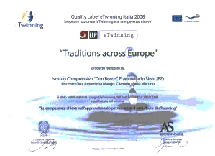 Every year, on June 24, the Romanians celebrate the most spectacular pagan holiday of the year: Sanzienele . This night it is believed to be magic, miracles are possible, beneficial forces, but also negative ones, arriving at the top of their powers.
Every year, on June 24, the Romanians celebrate the most spectacular pagan holiday of the year: Sanzienele . This night it is believed to be magic, miracles are possible, beneficial forces, but also negative ones, arriving at the top of their powers.
The celebration has its origins in an ancient solar cult. The name is probably taken after “Sancta Diana”, the forest goddess.
The origin of these traditions goes far back in time and their Dacian name is forgotten. The Roman name, “Sanziana”, coming from “Sancta Diana” is still used in Transylvania and the Slavonic one, “ Dragaica”, is still in use in Walachia and Oltenia.
The legends say that Sanzienele are some very beautiful girls, who live in forests or plains. They start a dance called “hora” and give special power to flowers and weeds, turning them into miraculous medicinal plants, good for all the diseases. The legends say that during this night fairies fly through the air or walk on earth. They sing and bring fertility to crops and to married women, to birds and animals, cure the sick, defend sown fields from hail. If people do not celebrate them in an appropriate way, they are upset, and take revenge.
 This day also represents an opportunity for young people who want to unite their destinies to meet, a celebration of love, done by singing and dancing. On the eve, girls and boys who are going to marry get together in each village. There are fairs and everyone is merry. The boys build bonfires, while the girls pick up yellow wild flowers that are also called “sanziene”. It’s a small yellow inflorescence rich in polen and smelling of hay and honey. The girls make garlands for themselves, for their home and for each member of the family. Then they go home and, at the sunset, they hang some of the wreaths to the doors, windows, barns, stables etc.and they throw the remaining ones on the roof of the house. If it stays there, it’s the sign that person will marry next year, if not, this will have to wait. For the old ones, the falling wreath means there will be no other such holiday. The higher it stops on the roof, the longer the life ahead.
This day also represents an opportunity for young people who want to unite their destinies to meet, a celebration of love, done by singing and dancing. On the eve, girls and boys who are going to marry get together in each village. There are fairs and everyone is merry. The boys build bonfires, while the girls pick up yellow wild flowers that are also called “sanziene”. It’s a small yellow inflorescence rich in polen and smelling of hay and honey. The girls make garlands for themselves, for their home and for each member of the family. Then they go home and, at the sunset, they hang some of the wreaths to the doors, windows, barns, stables etc.and they throw the remaining ones on the roof of the house. If it stays there, it’s the sign that person will marry next year, if not, this will have to wait. For the old ones, the falling wreath means there will be no other such holiday. The higher it stops on the roof, the longer the life ahead.
The ceremonial then includes the entire village. After the dark, men and boys go on the hills carrying torches that they turn around making them burn and spark intensely. It’s a contest and they cheer and shout as they do it. After midnight, when the torches are almost burnt out, they go down the hills, where girls and women join. They build a fire and jump over it for luck.
This day, which marks the middle of summer, was considered to be the best time to collect medicinal plants.
All are now making weather forecasts in order to determine the best time that autumn for wheat sowing. The dew that falls this night has magical powers, too. If you wash your face with it you will be good-looking and if you pick it from the flowers at dawn your bones will not hurt. Any object left outside during the night and wet with the dew can be an amulet.
This is supposed to be the day the cuckoo grows mute, turns into a hawk and leaves for the mountains, furious on the birds that can still sing. (Actually, the day when the cuckoo leaves is a total mystery and there is a proverb that says: ”The women will understand what men think when they will know the day the cuckoo leaves.”)
This night is one of peace and quiet, when storms never happen and even the wind is silent.
Class 8A, School no. 92, Bucharest


































































Recent Comments